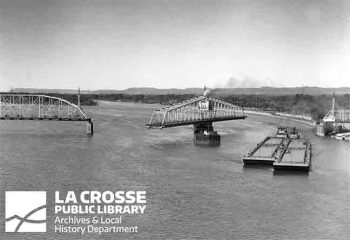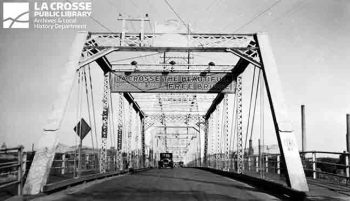
Third of a series
The Mississippi River, the superhighway of the mid-1800s when settlers sought new homes in Minnesota Territory, was valuable for traveling north and south but an impediment to traveling east and west. It was easier to cross the river during winter. But when there was no river ice, the earliest crossings from Hokah to La Crosse, Wis. were by canoe, rowboat or another primitive vessel. However, in 1854, two public ferries began operation. The “Wildcat” used horse power, using a thread power, assumed early area historian W. J. Langen. It docked on Target Lake on the Hokah side.
The other ferry, the “Honeoye,” ran from State Street in La Crosse and was controlled by Thomas McRoberts, a representative of the Kentucky Company, which planned for La Crescent to rival La Crosse in pursuit of commercial success. McRoberts, in 1857, received from the Minnesota legislature the right to operate ferries in Minnesota anywhere along the river from the southern boundary of Winona County to the north of the Root River. Meanwhile, the Wisconsin legislature granted McRoberts a limited charter to operate ferries from Wisconsin to Minnesota. In that same year of 1857, the “General Pope” offered service between Target Lake and La Crosse at lower rates. But this rival service was halted after McRoberts sued in a Minnesota Court.

Photos courtesy of the La Crosse Public Library Archives
From then on, without service to Target Lake, Hokah-area residents had to drive a team of oxen and wagon to La Crescent and then down to the Mississippi shore to access a ferry. That entailed also crossing the Root River to first get from Hokah to La Crescent. That involved a ferry across the Root until a bridge was built in 1862. But 12 years later, the bridge “went down,” and ferry business was needed again.
When the river was too high at La Crescent, the ferry had to dock farther north at River Junction between La Crescent and Dresbach – a few miles farther yet from Hokah. That made a long trip from Hokah, especially time-consuming with oxen pulling a wagon.
 By 1858, McRoberts operated a vessel named the “McRoberts,” which Langen said first charged from $1.10 to S1.50 per team, but he personally remembers a fee of 50 cents per team and 10 cents per person. This ferry made six trips to La Crosse daily, departing at 7, 9 and 11 a.m. and 1, 3 and 5 p.m. It was the only steamboat Langen ever saw with one big smokestack, instead of two smaller ones. “I used to enjoy going up on the deck and watching the big steamers go by.” He recalled the day when the ferry became stranded on a sand bar for about two hours.
By 1858, McRoberts operated a vessel named the “McRoberts,” which Langen said first charged from $1.10 to S1.50 per team, but he personally remembers a fee of 50 cents per team and 10 cents per person. This ferry made six trips to La Crosse daily, departing at 7, 9 and 11 a.m. and 1, 3 and 5 p.m. It was the only steamboat Langen ever saw with one big smokestack, instead of two smaller ones. “I used to enjoy going up on the deck and watching the big steamers go by.” He recalled the day when the ferry became stranded on a sand bar for about two hours.
In 1881 or 1882, there was a serious fire on board the “McRoberts” near the end of an afternoon trip. Fortunately, the boat was only about 200 feet from the landing, so all the teams and passengers were able to reach shore safely. But it was the end for the “McRoberts.” Langen’s parents were onboard that unforgettable day, and he never forgot his mother’s excited reactions.
Business between Minnesota and Wisconsin was better in winter without ferries. ”All the hours, miles and expense connected with the ferry made the people reluctant to patronize it,” said Langen. “Winter made a pleasant, much shorter and cheaper route to La Crosse by merely freezing solid the many lakes and sloughs in the Mississippi bottoms and furnishing a road of ice across the old river.
It was in between that commerce ceased almost entirely. During autumn when ice was forming and in spring when the ice began to melt, the ice road was deemed unsafe and ferries were not yet able to cross. “Once the road was opened in fall, there was a tremendous boom on in La Crosse.”
Going by ferry meant an entire day coming and going. Traveling the ice road took only two hours each way. When Langen hauled cordwood in winter, he made two trips a day.
The first bridge across the Mississippi was the railroad bridge of 1976, followed about 1880 by the old wagon bridge, a public facility. Both were swing bridges. The new Mississippi High Bridge (Cass Street Bridge) was built in 1939.
Source: “Just for Old Times Sake, History of Early Days of Hokah, Minn.” by W. J. Langen, 1949


Leave a Reply